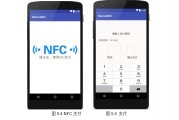基于安卓Android智能公交付费系统APP设计
来源:56doc.com 资料编号:5D20527 资料等级:★★★★★ %E8%B5%84%E6%96%99%E7%BC%96%E5%8F%B7%EF%BC%9A5D20527
资料以网页介绍的为准,下载后不会有水印.资料仅供学习参考之用. 密 保 惠 帮助
资料介绍
基于安卓Android智能公交付费系统APP设计(AndroidStudio)(任务书,开题报告,论文12000字,程序代码)
摘要
随着现代社会不断向前发展,城市规模越来越大。很多大城市的交通问题日益严重。如何解决交通拥挤问题是当前城市发展面临的必须解决的问题。本文主要研究从智能公交的发展方向,探索开发一款智能公交的付费系统,提高乘客付费的效率。同时也能够节约社会资源,加快公交系统运行的效率。现如今,移动互联网发展非常迅速。各行各业都积极引入互联网概念来促进行业发展。而且在移动操作系统的领域,Android操作系统占据极大的份额。同时智能手机的普及率逐渐提高,软件应用开发技术日趋完善。这些都为交通系统引入互联网概念提供了坚实的基础。
本文设计开发一款在Android智能手机上的APP应用程序,用于智能公交的付费。其主要应用Android系统应用框架,利用Android系统库文件进行开发。整个系统应用的后端数据存储建立在云端,利用Bmob公司的云平台技术。关键的付费功能则采用借助智能手机携带的NFC(近距离无线通讯技术)硬件功能的方法。
关键词:智能公交;Android;Bmob;NFC;Android虚拟机;Android应用框架
Abstract
With the continuous development of modern society, the scale of city is growing. The traffic problems are serious in many big cities.How to solve the traffic jam is a problem must be faced. The paper mainly explain how to develop a payment system of Intellectual Public Transit which can increase the payment efficiency of passengers . At the same time, it also can save the social resources and make the bus system work efficiently. Nowadays, the mobile Internet developed very quickly. The industries are actively introducing the concept of the Internet to promote development of themselves. And in the field of mobile operating system, Android operating system occupy great share. The popularity of Smart-phone also gradually increased at the same time and the technology of developing software become mature. These provide a solid foundation for the Intellectual Public Transit.
This paper focuses on developing a app in the Android Smart-phone for the bus payment. It is based on Android application framework that use the Android libraries.The back-end data storage of the entire system is built on the cloud, using Bmob's cloud platform technology.The key function use the NFC (Near Field Communication) function of Smart-phone’s hardware.
Key words:Intellectual Public Transit;Bmob;NFC;Android Virtual Device;Android Application Framework

目录
摘要 I
Abstract II
第一章 系统概述 1
1.1系统研究背景和意义 1
1.1.1 研究背景 1
1.1.2 研究意义 1
1.2 应用开发平台介绍 2
1.2.1 Eclipse 2
1.2.2 Android Studio 3
1.3 Android系统平台介绍 4
1.3.1 Android操作系统简介 4
1.3.2 Android架构 4
1.3.3 Android的Activity生命周期 6
第二章 系统分析 7
2.1 系统开发方案分析 7
2.2 系统核心功能分析 7
2.2.1 注册功能 7
2.2.2 充值功能 7
2.2.3 付费功能 8
2.3 系统可行性分析 9
2.3.1 技术可行性分析 9
2.3.2 系统应用前景分析 10
2.4 系统分析研究结论 10
第三章 系统设计 11
3.1 系统整体结构设计 11
3.1.1 系统整体功能需求 11
3.1.2 系统结构框图 11
3.2 系统UI界面设计 12
3.2.1 登录界面 12
3.2.2 注册界面 12
3.2.3 充值界面 13
3.2.4 付费界面 13
3.2.5 查询界面 13
3.3 核心技术模块 13
3.3.1 Bmob后端云 13
3.3.2 NFC技术 14
第四章 开发环境组建 16
4.1 JDK安装 16
4.2 Android Studio安装 19
4.3 Android虚拟机的生成 19
第五章 程序设计 21
5.1 系统UI界面及功能实现 21
5.1.1 登录界面及功能实现 21
5.1.2 注册界面及功能实现 22
5.1.3 充值界面及功能实现 23
5.1.4 付费界面及功能实现 24
5.1.5 查询界面及功能实现 25
5.2 Bmob后端云程序设计 26
5.3 NFC程序设计 27
第六章 系统测试 28
6.1 系统测试步骤 28
6.1.1 Android虚拟机测试 28
6.1.2 Android真机测试 29
6.2 系统测试结论 31
第七章 总结 32
致谢 33
参考文献 34
|



